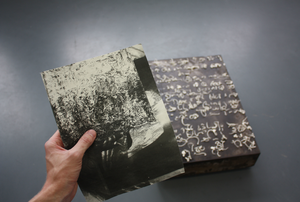Flatulance
It was the fifth of July, two thousand and sixteen, around eight o’clock at the opening of the Meisterschüler graduate show. The speeches had been made and the space was filled with visitors. There was a concrete plinth with a white, noodle-like constellation on its surface in the corner of the space where I then headed. Some visitors had already gathered around the object that, for this evening, I would declare a ‘text’. In my hand, I had a sheet of paper with an image on it. It was a greyscale digital print that, for the duration of the evening, would not really be discussed. I would declare the sheet of paper a ‘mobile artwork’.
An intervention began as I approached the visitors and explained to them that they were looking at a text that describes the artwork that I was holding in my hand. The Mobile Artwork was handed over to them so that they could give it a better look. It was usually compared to the object, which, when held in the hand, is perspectively a similar in size. This is usually where the discussion would start. Most questions revolved around the nature of the writing: the extent to which it can be read; its materiality and the process of its making*. This usually led to the evocation of the ‘conversation pieces’. The Conversation Pieces were not physically present within the space, but were vividly described and created in the visitor’s imagination. It was told that one of the objects (a worn enamel bowl) was essential in producing the writing. It was claimed that the other object (a brand new plastic tube) will be used in future time to manipulate the writing. Whether or not they really exist was not revealed to the visitor. With each visitor or group of visitors, the depth, level, pace, tension and intricacy of conversation and narration would differ. And so would the created imagery differ in its dynamism, vividness, and essential qualities.
Flatulance**: Mobile Artwork, Conversation Pieces, Text, as I have decided to title the work, materializes through various interrelated channels, namely as a text-object (modelling clay on concrete plinth) and its referential image-object (digital print on paper), as well as through the artist’s physical presence and his bodily and verbal expressions. But it also exists in immaterial form through the appropriation of the exhibition format and its ceremonial discourse, as well as through semantic-imaginative faculty.
The work is still developing or rather deteriorating. The task of creating the Conversation Pieces has been handed over to the exhibition supervisor. New visitors will hold and fiddle with the sheet of paper, leaving their traces onto the artwork. The images evoked in the minds of the visitors will become vague memories, but perhaps questions will grow. They may wonder if I have already flattened the writing and what it would look like. I am myself gradually forgetting what my readings of the image on paper were and the hybrid form of my writing is becoming ever more enigmatic to myself. At some point it will not be possible to retrieve much of my original linguistic thought from it. Only through wild speculation and new interpretation, could I attempt at making semantic sense out of it again.
_____
*
In some conversations with visitors I would go into a great deal of detail regarding the creation of the writing: Three days before the exhibition opening I went on site and arranged the items I would need to produce the text. This included my Mobile Artwork, a concrete plinth, a heap of modelling clay, a kettle, an enamel bowl (one of the Conversation Pieces), a large container filled with ice water and two syringes. In a meditative state, I would analyse and recollect my thoughts about the image (Mobile Artwork) in front of me. Water is boiled in the kettle and poured in the bowl. The syringes are filled with modelling clay and placed in the hot tub of water. I try to formulate my thoughts linguistically and, as soon as the clay is melted, I take the syringe and spray my airborne handwriting into the icy water. The linguistic formulations in my head proceed at the tempo of spoken language. The clumsy spray-writing can hardly keep up and as a result only some of the fleeting concepts materialize. The action of writing is a mixture of conventional handwriting from the English lexicon, of expressive gesture and impromptu symbol creation. As the liquid clay flies through the air and hits the cold water, a sudden transmutation occurs and it hardens into rigid shapes—like liquid thought crystallising into concepts. The formations are fished out and recomposed on the plinth surface. A slight adjustment to the syntax occurs. Due to the measure of improvisation and transformation in its production, it has become impossible to read the text as a standard written account.
**
The word “flatulence” generally refers to the accumulation of gas in the bowels. However, when related to language, it refers to inflated and pretentious speech or writing. The change from flatulence to flatulance could be read as a spoof on Derrida’s “différance”, hence eluding to his critical stance toward text and meaning. Morphologically, the spelling with “a” could also be seen as making the word seem more ‘French’ and hence seeming more lofty, like so many words of French origin in English. A concern with abjection (as that state where we become aware of our own “corporeal reality” or what is self and what is other) could also be read into the title. As bodily gas contained within the body, perhaps metaphorically it suggests a kind of incorporeal abjection, which occurs even before it has been cast off. Making us feel uncomfortable and estranged, when turbulent and still inside.
